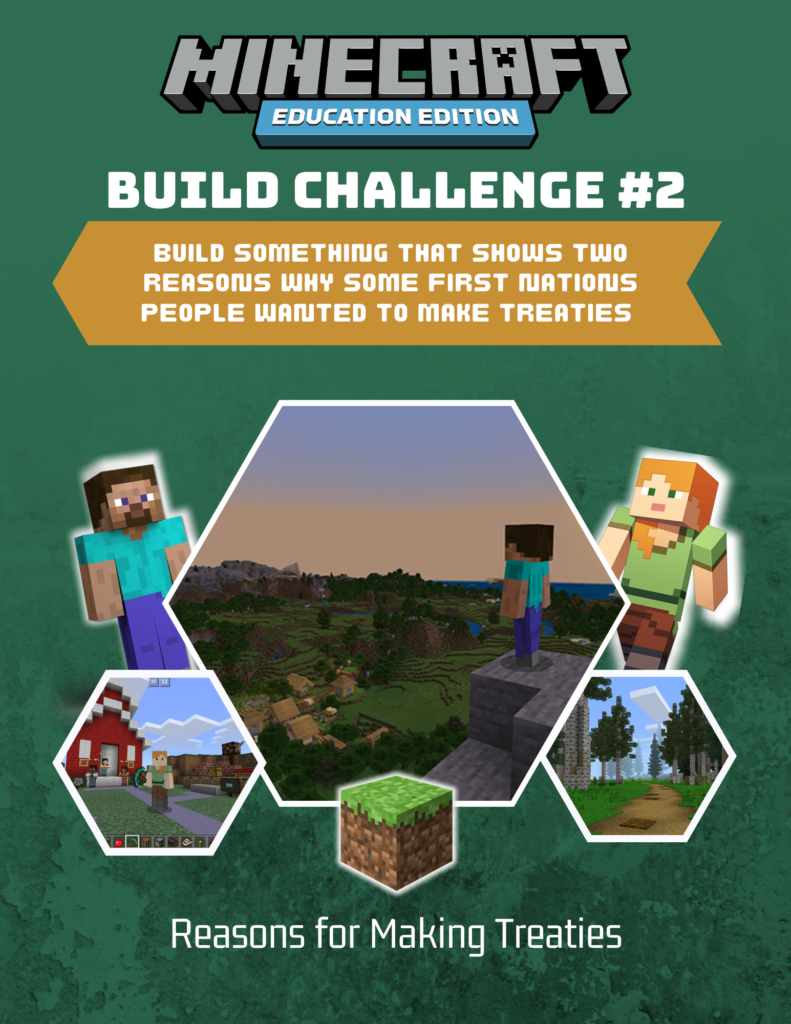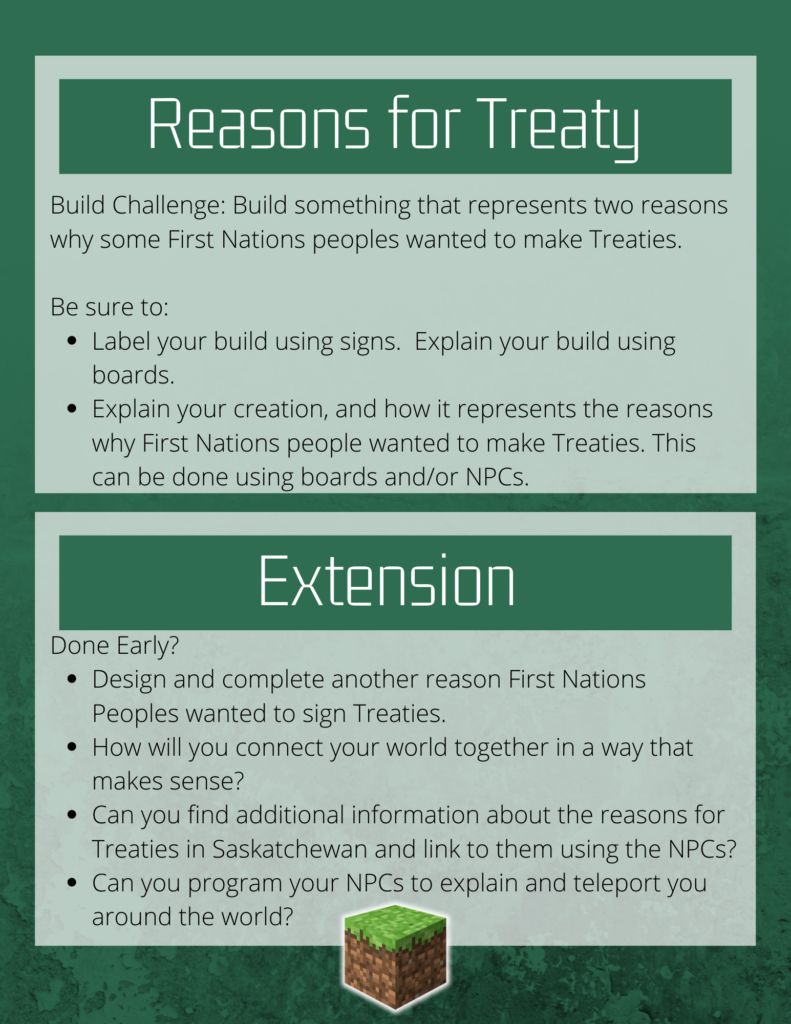*This post has been cross-posted with Curtis Bourassa.
This post will provide an overview of the Treaty Education and Minecraft Course we created for Grade 6-8 students in Saskatchewan. First off, check out our course walkthrough video:
We co-wrote several blog posts that document various aspects of the creation process. You can check them out here:
- Course Profile – Using Minecraft to (Literally) Build a Deeper Understanding of the Treaty Relationship
- Responding to Feedback – Building Off Your Thoughts: Treaty Education and Minecraft
- Student-Student & Student-Instructor Interactions – Building Meaningful Interactions In-Person, Online, and in Minecraft
We also wanted to share some reflections on course design, content creation, assessment, and receiving feedback and collaborating with Indigenous Knowledge Keepers and educators as these are all important parts of the creation process for this course.
Course Design
Our course design was inspired by UX Design, which Dr. John Spencer shared with us. (Be sure to check out this post that Curtis wrote on UX Design). Some of the major adaptations that we made to our course were to ensure that students and teachers who are using this course can easily navigate it. Some of these decisions around design included:
- Hosting our content on WordPress instead of Microsoft Teams to create a more user-friendly experience and enable us to share the course more broadly.
- Incorporating student feedback on how we can improve the course design.
- Including onboarding resources such as how to use Microsoft Teams, Class Notebook, and Minecraft. This provided opportunities for students to become more independent with the course. (link to videos)
Piloting the course with a few different classrooms has allowed us to self-reflect on lessons and tweak the course when needed.
Content Creation
Early in the creation of our course prototype, Curtis had the idea to create the build challenges in Canva. He based this idea on the Minecraft Sustainability Development Goals. We are proud of how they turned out and think teachers will appreciate having this package of build challenges to support the course.
We had originally planned to include tutorial videos for Minecraft skills but not instructional videos for the Treaty Ed/Social Studies lesson content, since we were going to teach those lessons synchronously anyway. We asked for feedback on that decision during class and reflected on it in this post. Our biggest concern was that if we created all the instructional videos, teachers might use them without digging into this content themselves. We know lessons are often much more impactful for students when they come from their teacher.
We were originally using some videos from the Office of the Treaty Commissioner (OTC) for our synchronous lessons, including:
- We Are All Part of Treaty (6 minutes)
- As Long As The Sun Shines (10 minutes)
We would watch the video and ask students to focus on a particular question (Example: What were the reasons the British Crown wanted to make Treaties?) while they watched. This worked okay, but we wondered if having a shorter video focused on the specific topic would streamline things for students. We decided to try it out and created this video using Canva and Camtasia:
We are planning to create a few more instructional videos to support the lessons and build challenges. We still want to encourage teachers to do their own teaching that supports this content, so we are keeping the videos short and hoping that they provide jumping-off-points where teachers could go into the topics in more depth.
Assessment
Our course assessment involved student input as much as possible. This included co- constructing expectations in Padlet as well as co-constructing criteria to assess the build challenges. Students provided ideas on what they wanted to be assessed on, and we turned it into a single-point rubric.
Students are formatively assessed after every build challenge and provided the opportunity to review the feedback and improve their builds at specific times throughout the course. At the end of the course, students will be given time to review all the feedback from their build challenges and improve their world. After their group’s final submission, students will receive their summative assessment.
Students will show their individual knowledge on course content through Flipgrid by walking through their Minecraft worlds and explaining their builds using the Flipgrid Screen Recorder. This will ensure that we have individual student voices, perspectives, and understanding throughout the course.
Throughout the course, students will complete regular self and group assessments to reflect on their individual contributions and assess group dynamics. After the first self/group assessment, we used student responses to help groups problem-solve any issues they were having. We were clear that students were rating their group as a whole, not grading each other individually. This helped keep the reflections solution-focused. We had students submit their self and peer assessment through Microsoft Forms. You can make a copy of the form we created using this link!
Receiving Feedback & Collaborating with Indigenous Knowledge Keepers and Educators
We have attended several webinars on the Manito Ahbee Aki world and educator resources. In these sessions, the Indigenous Education team from Louis Riel School Division emphasized the importance of working with Elders and Knowledge Keepers during the creation of this world. Raquel was also reminded of the importance of sitting down with Elders to listen and learn before and throughout projects when she watched this video from Saskatchewan Indigenous Cultural Centre with Knowledge Keeper Robert (JR) McArthur.
These are some quotes from Melody Wood and JR McArthur from the video (taken from 13:15-16:25) that got us reflecting on our creation process and the need for feedback and collaboration:
Melody: One of the things I truly appreciate about you is that you didn’t just start creating [Nakota lullabies]. You actually sat down with Elders to talk about what they knew, you did a bunch of research and background into lullabies, before you even started creating about it. I just want people to hear about why that is important to you – to do that before you start creating lullabies.
JR: Doing that – it was just for me. It’s who I am. I need to sit and I need to hear that from experience. Being able to sit in front of somebody older than you and just sit there and be the student. No matter how old we get, we’re always the student. To be able to sit there and put in that time… It just lets you know that you are doing something good. And when the feedback is more than you expected, it’s great. It makes it even worth more than you thought… to have those older individuals tell you, you’re gonna do something good.
JR: …That’s kind of why you do it, you reaffirm yourself and you let people know. And at the same time, you get that feedback. There’s always that one thing. When you put in enough time you’ll find there’s always that one little thing that you’re gonna find that you’ve never heard before, and someone tells you… That feedback that you get by putting in the time is… you just can’t say enough about it. That’s just part of learning.
We want this course to be authentic, respectful, and done in a good way. We have feedback/collaboration meetings set up with several Indigenous people that we have working relationships with. We are looking forward to sitting down with them, sharing what we have developed so far, listening to their thoughts and feedback, and potentially collaborating with them to improve the course.
Curtis also did a podcast interview with two members of the Indigenous Education team from Louis Riel School Division who were involved with creating the Manito Ahbee Aki world. We are looking forward to continued conversations with their team as well!



Hey Curtis and Raquel, to say I am impressed with what you have built would express what the both of you have created. You have taken an important topic and turned it into a creative and engaging unit that lends itself to all kinds of learning. I like that you have had the opportunity to implement your modules with different classes, reflect on the process and then adjust to make it better. Your finished product looks amazing! Will you be sharing this with all teachers in the province or just within your division?
Thanks so much, Gerod!! It has been really helpful to pilot it with a few classes and adjust as we go. We would like to finish creating all the modules and then continue to get feedback from teachers and Indigenous Elders, Knowledge Keepers, and educators before we share it more widely. We would love to share it with all teachers in the province eventually, but we want to take things slow and make sure we do things in a good way!
WOW! This is fantastic. How did it go presenting this at the conference you were talking about? I am excited to see more of it, and I am even more excited to potentially use it with my kiddos one day. I do not know how to use Minecraft, but I definitely need to get more invested in it, as this looks really engaging for students. I also like how you used an engaging concept to immerse students in learning about a topic that too often gets missed, or skipped because people feel uncomfortable teaching it. So great job! I am so excited to hear more about it!
Thanks so much, Kelly!! The conference presentation went well, but we didn’t get as much feedback as we were hoping for. There weren’t a lot of teachers at the conference – it was more board members, superintendents, etc. I like to think we would have gotten more feedback if we were sharing this with a room of middle years teachers! I had never used Minecraft before starting this project, so it was quite a learning curve for me. It can seem tricky at first but once you catch on, it’s so much fun! Curtis made some great beginner tutorial videos if you ever decide to try it out. Thanks for reading!
Pingback: Tools for Online Learning: Is the Medium Really the Message? - Raquel Oberkirsch Portfolio & Blog